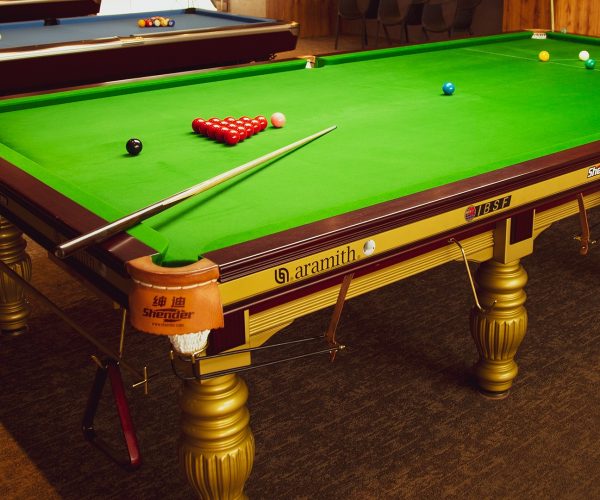Assembly Language or Machine Code ?
페이지 정보
작성자 Adela 작성일24-07-07 11:23 조회24회 댓글0건관련링크
본문

Note that these two other balls are already on the table, and remember that white and yellow are the cue balls. Most of the time, you will use 16 balls (including the white ball). A User Datagramme Protocol is added for programmes that need only IP, choosing not to use the control that is provided by TCP. It became obvious that the addressing system of Network Control Protocol, based on the Interface Message Processor of Arpanet, was insufficient for an open network, and therefore another protocol with control of transmission errors should eventually have to be devised. This new one would be later called Transmission Control Protocol / Internet Protocol, whose fundamental characteristics were defined by Mr. Kahn in a report named "Communication Principles for Operating Systems": -Each local area network is independent, internal changes are not mandatory for its connection to Internet. Gopher: protocol developed at the University of Minnesota in 1991 (a gopher is the mascot of that university).
Lisp, List Programming: a language created by John Mc Carthy (Stanford University), presented at Darmouth College in 1956 and since 1958 developed at the Massachussetts Institute of Technology. 1965: Thomas Merrill and Lawrence G. Roberts connect a Q-32 computer at the University of California with a TX-2 computer at the Massachussetts Institute of Technology, using a dial-up low speed telephone line, and thus making the FIRST LONG DISTANCE COMPUTER NETWORK IN HISTORY. They were usually numbered in intervals of ten or another number, thus making it possible to insert new lines without need of numbering all lines again. In 1964 little over ten elements could enter in a square centimetre. 1964: first computer with main processor entirely built as integrated circuit (of little over ten elements per square centimetre). Interface Message Processor. Robert Kahn (B. 1989: proposal of a World Wide Web, system of linked information able to work with different kinds of computers, by Tim Berners-Lee and Robert Caillau (Centre d'Etudes sur Recherche Nucleaire, Genevre, Switzerland). August 1962: essay on a "Galactic Network" of computers, by J. C. R. Licklider (Massachussets Institute of Technology).
August 1968: after Lawrence G. Roberts and his DARPA group had defined the specifications for Arpanet, a group led by Frank Heart (Bolt Beranek) and by Newman (B. 1968: B 2500 and B 3500, computers built with integrated circuits, by Burroughs Corporation. 1963: PDP-5, Programmed Data Processer-5, by Kenneth Olsen (Digital Equipment Corporation). Examples of strong dialects are QuickBasic, QBasic, Basic PDS or Visual Basic, all by Microsoft Corporation. Basic was therefore a simplification of them, with most key words taken from Fortran II and some taken from Algol 60. The first dialect of Basic, now called Dartmouth Card Basic, was a non-interactive dialect based on a standard card reader, intended for batch processing. Less than 100 languages have been widely used (in some of them, only a few dialects have been widely used). 1970: it is calculated the existence of about 100 000 computers in the world. 1970: Intel 1103, integrated circuit of 1 Kilobit in Random Access Memory (Integrated Electronics, Santa Clara, High California). 1972: Intel 8008, microprocessor of 16 Kilobytes of 8 bits. At a price of 200 Dollars, the Intel 8008 was used in scientific calculators and in two very early microcomputers: Scelbi-8 H of 1973 and Personal Minicomputer Mark-8 of 1974. March 1972: first elementary application of electronic post for Arpanet, only with the functions "Read" and "Send", by Ray Tomlinson (B.
The group of Glen Culler and Burton Fried at the U. C. S. B. take research on mathematic functions for network visualisation, while that of Robert Taylor and Ivan Sutherland at Utah concentrate on methods for third dimension representation of the network. The computers interchanged meaningless data while about twenty people watched the historical event, which MARKS THE START OF INTERNET. This institution gradually lost control of the Internet, in favour of the Internet Activities Board. 1971: Project Gutenberg. In the course of time it would become the biggest library in the Internet, with over fifty thousand books in 2016 (most of them in English, although over forty languages are represented with at least one book). Those books are available in electronic format in at least two on-line collections: Project Gutenberg and Many Books, hyper linked below. Some of those quasi natural languages are intended to be immediately interpreted, others are meant to be translated later, and others can be interpreted or translated (Basic, Forth or Lisp are examples of the latter). Sitting for extended periods can cause discomfort if the chair lacks proper cushioning. Hit the cue ball using the other cue ball and then target the red ball, which should not be pocketed to earn two points.
If you have any questions regarding where and ways to utilize what is billiards, you could call us at our web-page.
댓글목록
등록된 댓글이 없습니다.




